We were recently chatting about how groundbreaking in design the Studebaker Hawk was compared to some other offerings at the same time, but this 1959 Citroen ID 19 blows them all out of the water! This futuristic (even now) sedan can be found here on eBay in Wrightsville Beach, North Carolina. There is a $7,500 buy it now price and a current bid price of $2,225.
Talk about a 60-year-old look into the future, these Citroens had to have been mind-blowing at a time when giganotosaurus cars like the ’59 Cadillac and others were driving around. And then here comes Citroen with the DS and ID in this crazy sleek design. To top it off, the DS came out in 1955 when most American cars were big, tall, wide, driver-wearing-hat type of cars.
Meet George Jetson. His boy Elroy. Daughter Judy. Jane his wife… The Citroen ID model was more of their base level car compared to the fancier DS that most of us think of when we see a Citroen. Post-war France was still hurting and introducing the expensive DS at a time when a lot of people couldn’t afford them forced the company to think about a cheaper solution, such as the ID.
The steering wheel is as simple and elegant as it gets. The rest of the interior looks pretty nice. The seller says that this car runs and drives but it needs help with the hydraulics. The brakes and suspension are both kaput due to hydraulic problems. The buy it now price is about what Hagerty lists for a #4 fair condition DS so with lots of work needed on the hydraulic system and elsewhere on this ID, it may be a stretch, but all it takes is for a couple of bidders to want it and drive the price up.
The seller has “Toyota Supra” listed for the engine which would be somewhat of an upgrade, to say the least. It actually should be Citroen’s 1.9L inline-four with 65 hp. It runs and drives fine and the transmission shifts like it should but those pesky hydraulics will need to be gone through and that won’t be inexpensive. The underside is as interesting as the rest of the car is. Is that an engine crank in the underside photo? Have any of you owned a Citroen DS or ID 19?
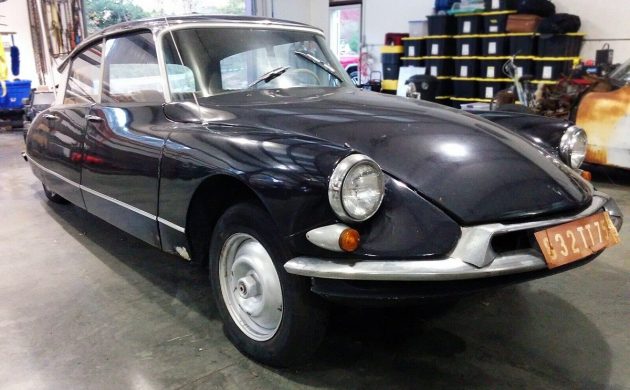
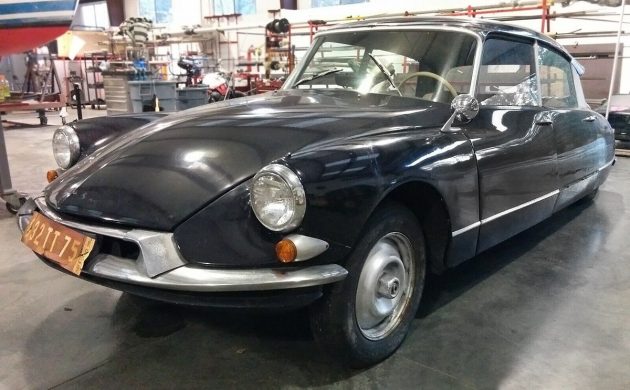
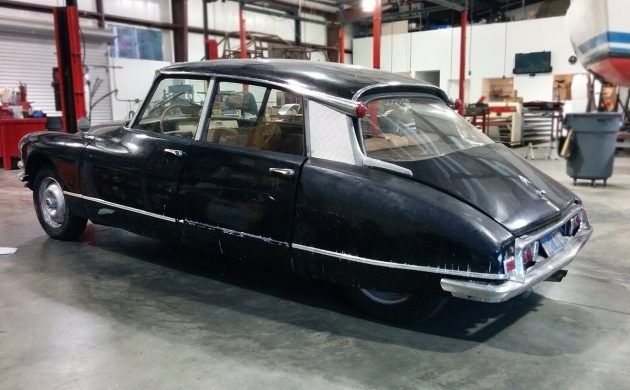
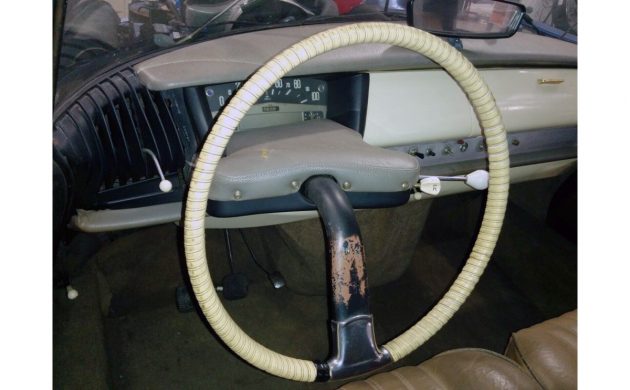
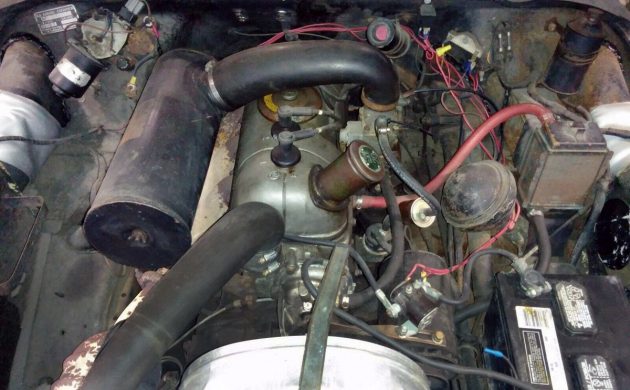


“needs help with the hydraulics” are words you never want to hear when considering a Citroen
Or a MB 600….
Parts sourcing will be a nightmare on this one. Any buyer had better hope he has access to someone who knows these cars. I can see $10K alone just to get this running & stopping properly, and I’m probably low-balling it. Interesting cars, but you had better know what you’re getting into when you acquire a `55-`64 Citroen ID or DS model.
Parts are not a problem. I can get anything for my SM and there were lots more of these made…
And people were complaining that the Packard Hawk’s nose looked like a catfish ? The Citroen used the catfish design for years !
You know , the front end does have a Studebaker look to it ; if you could make the car sit level, radiused the rear wheel arches and, put on some Stude hubcaps with the big “S,’ it could pass for a 50s Stude prototype !
“Is that an engine crank…?” No, it’s a wheelbrace.
Brakes and suspension both? Start with a recon pump and work your way out. Floaty Citroëns are fab, and not too bad to work on once you get your head round them.
Thanks for the info, Derek! I was trying to think of the last car made that had an engine crank but I guess by the late-50s they were probably long gone. MG maybe?
Hey Scotty, the Lada Niva was still sporting a hand-crank into the ’80s…not sure if they still do.
The early 60s Datsun Bluebird had a hand crank. I only know this because I remember my mother having to use it quite often so she could drive 500 yards to the shop. I reckon that would have to be getting real close to the last car produced with the crank option.
I really like Citroens but after my Mercedes coupe woes, I like to see hundreds of examples of a car on the road getting around daily so I know I can keep the shirt on my back when something goes pear-shaped.
My 1969 DS21 has a hand crank.
2CV had one right to the end (1990).
Actually, D model Cits had crank holes through 1975. As a long time Cit owner, I used to crank start as a joke occasionally.
My 1969 DS has a hand crank.
Could that “crank” be a wheel lug nut wrench?
Yes, the wheel lug wrench doubles as the end of the crank. It fits into a longer shaft that goes through the bumper, under the radiator, and into the transmission.
Parts aren’t all that bad for this — I know of at least two sources that can get what you need for both hydraulic and mechanical bits — but the thing that might be of concern is the fluid to use. If this is an actual home-market car (I’m guessing, based on the Paris-registration front plate) it might have originally used a mineral oil that wasn’t allowed for U.S.-import cars. We got brake fluid instead. And, later, LHM (green) fluid. None of these can be mixed. The seals and rubber bits in the system don’t like having that done to them.
I would be tempted, but I owned a DS21, which had hydraulic operation for the transmission as well as suspension, brakes, and steering assist. That’s one of two “automatic”-transmission cars I’d want to have now. DSes are in a world of their own when it comes to comfort and driver convenience.
Everything but the hydraulics is pretty normal to work on, and reliable.
I love the dashboards of the earlier cars! This one is not quite as space-agey as the original, but later cars (like mine) were more normal (relatively) inside.
The next owner is going to be in for a treat. As long as they pour the right fluid into the reservoir, that is….
The ID models had the simpler dash. The DS models had the space age plastic. I had a ’59 ID19, and I loved that the turn signal switch was on the dash, and blinked a very pretty green. I saved the switch when the car was totaled by a drunken Country Squire owner.
The brake fluid (LHS) cars suffered from the fluid absorbing water, which caused nightmares for the hydraulics. That’s the one thing that would hold me back on this one.
My concern would be that someone has already mixed fluids, causing the problems it has now, and that means everything needs to be cleaned out and probably rebuilt.
Compared to modern cars, even with the “complicated” hydraulics, the ID modelsb are not difficult to work on, provided you have the repair manual.
In 1964 I bought a 1959 ID-19 with 15’000 miles on it , drove it for 3 years and loved it! Bought a new ID-19 in 1966 and drove it for over 100,000 miles. The four cylinder engine was an old taxicab design from the 1930s. Very reliable, had neither an oil pressure gauge nor an oil pressure warning light. Did not need it! :-))) I am 90 years old now, still have everything so vivid in my memory that I could write a book about it.
The phrase I used back in the sixties and seventies in regard to the D series was, “once you have a Citroen, everything else is a compromise”.
The car is mostly US spec, the TT in on the plate means a car that will
be expoted from France.
Sorry typing too fast, exported from France,mostly overseas delivery setup through a US dealer.
Back in the 1950s it seemed as though these cars must have been dropped to earth from a flying saucer! :)
A long drop might explain the styling.
Great cars to drive. Not quick, but can cruise all day at 80. Had the lowest Cd of .28 (I believe). Considered the most beautiful sedan of the 20th C. I think the seats in this car are from a later model DS21 Pallas. Dave Burham in NY is the go-to guy for these cars. I had over 300K miles on my 1967 DS, died due to rust, nothing mechanical.
Still looks just as wild 60 years later.
And I just love the steering wheel on these things..
It just looks like something that shouldn’t work!
Note the single lug wheels. Indycar style. Also the rims are 400mm, which is like 15.75″.
The wrench you see in the underside photo is part of the engine crank and also serves as the wrench to remove the single bolt that holds the rear fender on (so you can change a rear wheel). This car is early enough that it uses the single lug wheels. The wheel has a hexagon formed on the back side. This fits onto a hexagonal expanding collet, which holds the wheel on as you tighten the single bolt through the center of the wheel to 125 ft-lbs. Citroen DS retained the ability to hand crank the engine on all cars except the 5-speed manual, which was introduced shortly before production ended in 1975.
If it is a 1959, it is a brake-fluid compatible or “Red Fluid” system.
The hydraulics on there were/are a nightmare.Stay clear!
@luke_arnott – not all all true. Citroen would not have been able to sell well over a million DS-family cars if they were such a nightmare. A mechanic does need to take the time to understand the system before wrenching on them, but that also is true for “nightmares” like automatic transmissions.
Thank crank looking piece nylon tied to the cross piece in the engine compartment where the spare tire goes, is dual purpose. It’s the wrench used to remove the rear fenders, for access to the rear wheels. It also hooks onto the long Allen like wrench that is used to remove the one bolt wheel rims. Those are then put through a hole under the front bumper, which leads to an extension on the front of the transmission. In that extension, is a racket like section similar to where cranks go into earlier cars that had hand cranks, but acted as a one way device, to disengage the hand crank, if the engine tried to run backwards. Meant to prevent broken arms. The engine can be hand cranked if needed. It also serves to rotate the engine when setting the ignition timing. This is done by rotating the engine to almost Top Dead Center, then a round rod is inserted into a hole on the bell housing on the driver’s side. The engine is then rotated until the rod drops into a slot in the flywheel, that is the timing position. The ignition is set statically. A word of caution, don’t let a friend sit in the car while setting the timing and say “hey, what’s this little red button”, and proceeds to push it. That is the starter button, and removing a now bent rod, can be a bit of a chore.
The part that scares me the most is how it seems they have been driving it around without brakes or suspension, and the system dry. Earlier versions of the ID models like this one, usually have a one cylinder piston pump, driving off the engine’s camshaft. Unless there is a system disassembly, or a hydraulic pressure restore, a potential buyer has no idea if it’s all capable of working, or all seized up. The deteriorated boot at the bottom of one of the suspension cylinders on the front wheel, means the system may have been exposed to moisture.
These things look like cucaraches!
Fantastic cars. Not really hard to fix or maintain. Nothing drives like them! Plus parts are available.
I agree these cars are great to own, drive and work on. The suspension require good spheres and factory recommended hydraulic fluid. Don’t use anything else!! Cheap at the advertised price. Parts readily available.
Keith Johnson, did you used to live in Mundeline Illinois and have a dog named Rupert?
I certainly did! So…you’re either someone from the old Central Citroen Club, who met Rupert on a camping trip in Indiana, or my ex-boss from a Goodyear store from my youth!
Ex-boss,
Contact me at.
[email protected]
Amazing. Email sent.
Wayne had a dog named Portia, iirc. Ya know, like Porsche is supposed to sound.
We last saw each other about 1979 or 1980.
The AKC would not let us name her Porsche. So her name was Portia Giulietta!
She was a wimpy Beagle! I don’t miss her at all. (Ex-wife’s dog)
Love Studes and Citroens, had lots of them as daily drivers. This one shows really nice. Hydraulic problems can be solved quickly if you have an entrance with Citroen fanatics around the world. I even have an original workshopmanual for the CX series and some contraption to refill the Balls – whatever they may be called in english, (Spheres) Owned some Dianes, GS series, BX series and CX 2.5 GTi automatic with autostart. Should have seen (local) spectators when the car was standing over there and then depressing the start button – nobody inside and this car was coming up to level ….. For me they were reliable cars, both Studes and Citroen. But I’m a sorry mechanic…… for 57 years only.
Too old now to bother with oldtimers, just windowshopping for the fun of it.
However, wouyld like to own a ’60 Lark Hardtop like the one I left back in the Netherlands. Anyone to help out?????